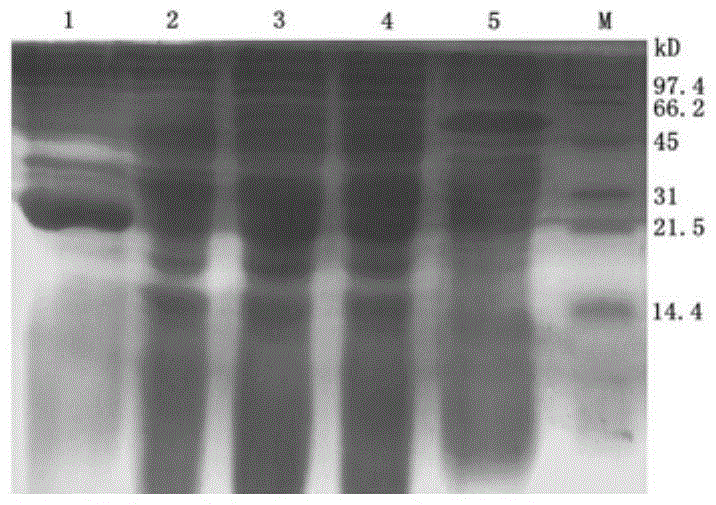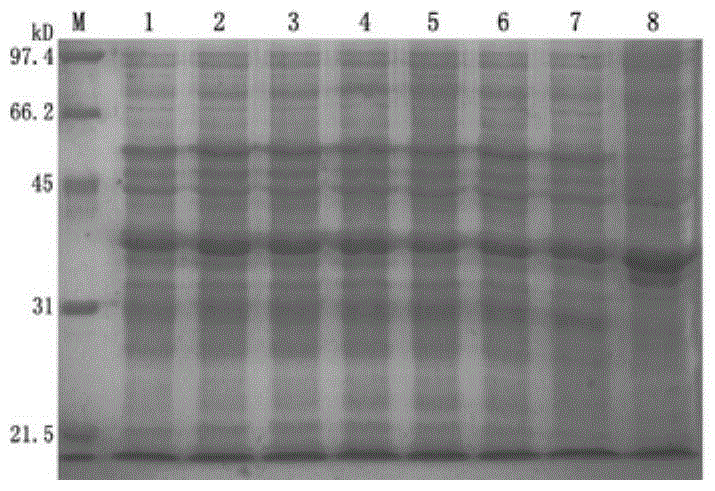B-cell epitope of VP(viral protein)3 of DHAV (duck hepatitis A virus)-1 as well as identification method and application of B-cell epitope
A technology of duck hepatitis A virus and its identification method, applied in the field of B cell epitope of VP3 protein of type 1 duck hepatitis A virus and its identification
- Summary
- Abstract
- Description
- Claims
- Application Information
AI Technical Summary
Benefits of technology
Problems solved by technology
Method used
Image
Examples
Embodiment 1
[0054] A B cell epitope of type 1 duck hepatitis A virus VP3 protein, the amino acid sequence of which is shown in SEQ ID NO:4 or SEQ ID NO:5.
[0055] The use of the B cell epitope of the VP3 protein of type 1 duck hepatitis A virus can be applied to a kit for detecting the infection of type 1 duck hepatitis A virus or the level of vaccine antibodies.
[0056] Further, the B cell epitope of the VP3 protein of duck hepatitis A virus type 1 is used as an antigen in the kit components for detecting the infection of duck hepatitis A virus type 1 or the antibody level of the vaccine.
[0057] A use of the B cell epitope of the VP3 protein of the type 1 duck hepatitis A virus, wherein the B cell epitope of the VP3 protein of the type 1 duck hepatitis A virus is used in the preparation of a vaccine for preventing the type 1 duck hepatitis A virus.
[0058] A kind of identification method of type 1 duck hepatitis A virus VP3 protein B cell epitope, comprises the following steps:
[...
Embodiment 2
[0105] The expression analysis of embodiment 2 recombinant protein and the optimization of expression condition
[0106] experiment method:
[0107] 1. Expression analysis of recombinant protein
[0108] Escherichia coli BL21(DE3) positive bacteria transformed with the recombinant expression plasmid pGEX-VP3 were inoculated into LB(Amp+) liquid medium, and activated overnight at 37°C. Take the activated bacterial solution and inoculate LB (Amp+) liquid medium at a volume ratio of 1:100, and expand the culture at 37°C for 3 to 4 hours until the A600 is about 0.6. Add a final volume of 0.4mmol / LIPTG, and induce expression at 37°C for 4 hours. After the end, the bacterial solution was centrifuged at 8000r / min for 5min to collect the bacterial precipitate, and 20mmol / LTris- Suspend in Cl (pH 8.0) solution, break up the bacterial cells in an ice-water bath with ultrasonic waves for 60 s, with an interval of 60 s, and repeat until the bacterial liquid is clear and transparent. Th...
Embodiment 3
[0119] Embodiment 3 A kind of identification experiment result of type 1 duck hepatitis A virus VP3 protein B cell epitope
[0120] 1. Preparation and potency determination of VP3 recombinant protein polyclonal antibody
[0121] Use the purified VP3 recombinant protein to immunize male rabbits to prepare antiserum. The specific steps are: firstly, use 0.5 mg of VP3 recombinant protein solution and an equal volume of Freund's complete adjuvant to emulsify into water-in-oil state, and then apply multiple points intradermally and subcutaneously on the back of the neck. Inject rabbits; 11 days after the first immunization, use 1 mg of VP3 recombinant protein solution and an equal volume of Freund's incomplete adjuvant to emulsify into a water-in-oil state, and inject rabbits subcutaneously at multiple points on the back of the neck for the second immunization; 22 days after the first immunization, use 1 mg After the VP3 recombinant protein was emulsified into a water-in-oil state ...
PUM
 Login to View More
Login to View More Abstract
Description
Claims
Application Information
 Login to View More
Login to View More - R&D
- Intellectual Property
- Life Sciences
- Materials
- Tech Scout
- Unparalleled Data Quality
- Higher Quality Content
- 60% Fewer Hallucinations
Browse by: Latest US Patents, China's latest patents, Technical Efficacy Thesaurus, Application Domain, Technology Topic, Popular Technical Reports.
© 2025 PatSnap. All rights reserved.Legal|Privacy policy|Modern Slavery Act Transparency Statement|Sitemap|About US| Contact US: help@patsnap.com



